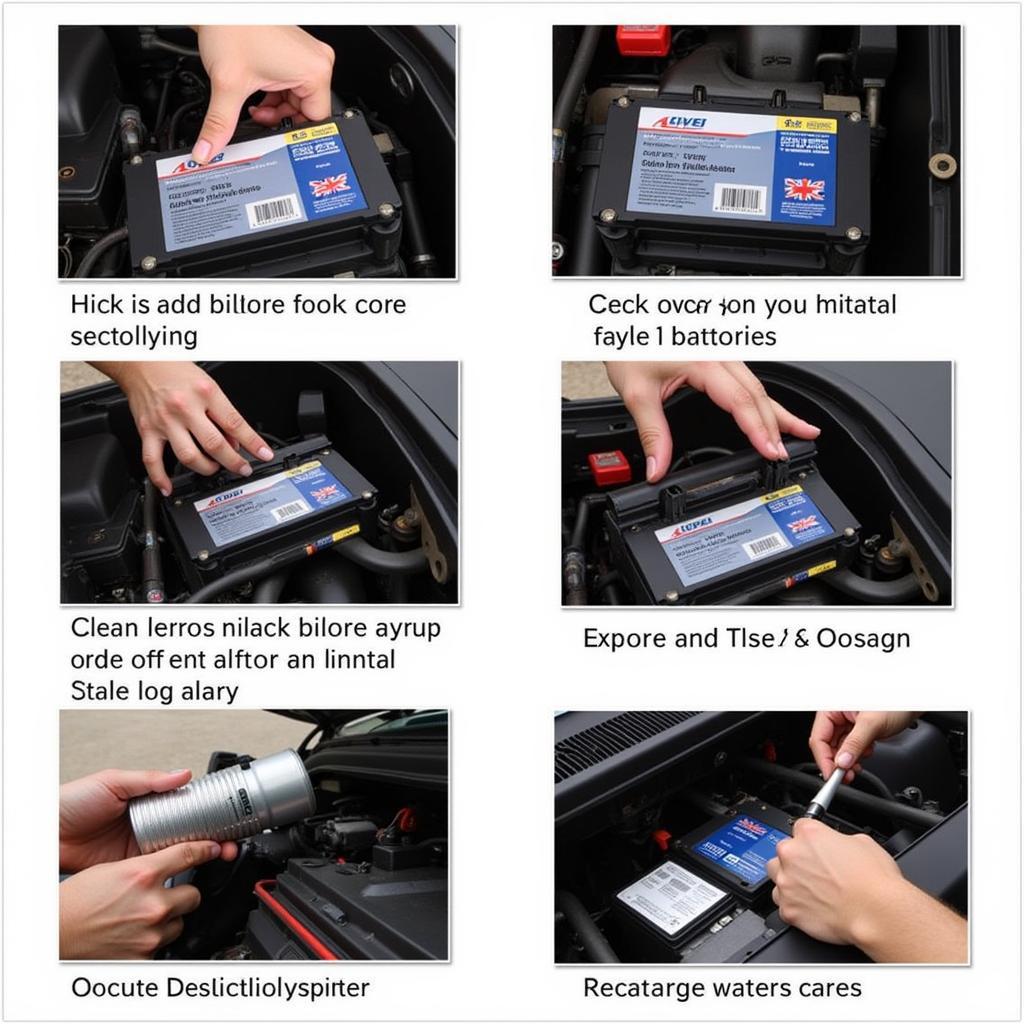Repairing a car battery cell is a delicate process that requires careful attention and understanding of battery construction. While replacing a dead battery is often the easiest solution, understanding how to repair a car battery cell can save you money and potentially extend the life of your battery. Let’s explore the intricacies of car battery cell repair and whether it’s a feasible DIY project. This article will guide you through the process and help you decide if attempting a repair is the right choice for you. Want to learn more about general car repairs? Check out can a car be repair at home.
Is Car Battery Cell Repair Possible?
Yes, in some cases, individual car battery cells can be repaired. However, it’s crucial to understand the complexities involved. Car batteries are typically lead-acid batteries, consisting of six interconnected cells, each producing approximately 2.1 volts, totaling 12.6 volts. Damage to these cells, often from sulfation or physical damage, can reduce the battery’s overall performance. Identifying the damaged cell is the first step in the repair process.
A common issue is low electrolyte levels, which can be easily addressed by adding distilled water. However, more severe damage, such as a cracked case or internal short circuits, often renders the entire battery irreparable. Before attempting any repair, you must assess the extent of the damage and determine whether a repair is worthwhile. Wondering if your battery can even be repaired? Find out more at can a car battery be repaired.
How to Repair a Car Battery Cell: A Step-by-Step Guide
If you’ve determined that a repair is possible, here are the general steps involved:
- Safety First: Always wear safety glasses and gloves when working with car batteries. Battery acid is corrosive and can cause serious burns. Ensure proper ventilation as batteries can release flammable gases.
- Identify the Damaged Cell: Use a multimeter to measure the voltage of each cell. A significantly lower voltage than the others indicates the damaged cell.
- Clean the Battery: Thoroughly clean the battery terminals and case using a baking soda and water solution. This will remove any corrosion and improve conductivity.
- Address Low Electrolyte Levels: If the electrolyte level is low, carefully add distilled water to each cell, bringing it to the designated level.
- Attempt Cell Repair (If Possible): Depending on the damage, specialized techniques may be employed. For example, Epsom salt solutions can sometimes desulfate a cell. However, these methods are not always successful.
- Recharge the Battery: After attempting a repair, recharge the battery using a suitable charger. Monitor the charging process and ensure it completes successfully.
- Test the Battery: After charging, retest the battery voltage and perform a load test to ensure it’s functioning correctly.
 Repairing a Car Battery Cell – Step-by-Step
Repairing a Car Battery Cell – Step-by-Step
When to Replace, Not Repair
While some cell repairs are possible, it’s often more practical to replace the entire battery. If the battery case is cracked, severely damaged, or the cells are consistently failing, replacement is the recommended course of action. Attempting to repair a severely damaged battery can be dangerous and ultimately ineffective. Need help with car and scooter repairs? Find professionals at who repair car and scooter.
What are the signs of a failing battery cell?
Some common signs include slow engine cranking, dimming headlights, and electrical malfunctions.
Can I repair a car battery cell at home?
Yes, some minor repairs can be attempted at home, but always prioritize safety and consider professional assistance for more complex issues.
“Repairing a car battery cell requires a good understanding of battery chemistry and safety procedures. It’s not a task for the faint of heart,” advises John Smith, Lead Automotive Technician at Smith’s Auto Repair. “While some DIY repairs are possible, consulting a professional is always recommended, especially for complex issues.”
Conclusion
Understanding how to repair a car battery cell can be valuable knowledge for any car owner. While some repairs can be performed at home, it’s crucial to prioritize safety and carefully assess the extent of the damage. In many cases, replacing the battery is the most efficient and safest solution. By following the guidelines outlined in this article, you can make an informed decision about whether to repair or replace your car battery. Remember, a well-maintained battery is essential for reliable vehicle operation. Looking for more information on whether a car battery can be repaired? Visit can car battery be repaired.
 Fully Recharged Car Battery Ready for Use
Fully Recharged Car Battery Ready for Use
FAQ
- How long does a car battery typically last? Typically 3-5 years.
- What causes car battery failure? Common causes include sulfation, extreme temperatures, and overcharging.
- Can I jump-start a car with a dead cell? Yes, but it might not hold a charge for long.
- How do I dispose of an old car battery? Recycle it at a designated collection center.
- Are all car batteries repairable? No, severe damage often necessitates replacement.
- What are the signs of a bad car battery cell? Slow cranking, dimming lights, and electrical issues.
- Is it safe to repair a car battery cell myself? Yes, with proper precautions, but professional help is often recommended.
“Regular maintenance, like checking electrolyte levels and keeping the battery clean, can significantly extend its lifespan,” adds Maria Garcia, Certified Automotive Instructor at Garcia’s Auto School. “Early detection of issues can also prevent more serious problems down the road.”
Need further assistance with your car battery or other car repairs?
Explore our other helpful articles, such as why do cars need an emergency repair kit.
For personalized support, contact us via WhatsApp: +1(641)206-8880 or Email: [email protected]. Our 24/7 customer service team is ready to assist you.

Leave a Reply